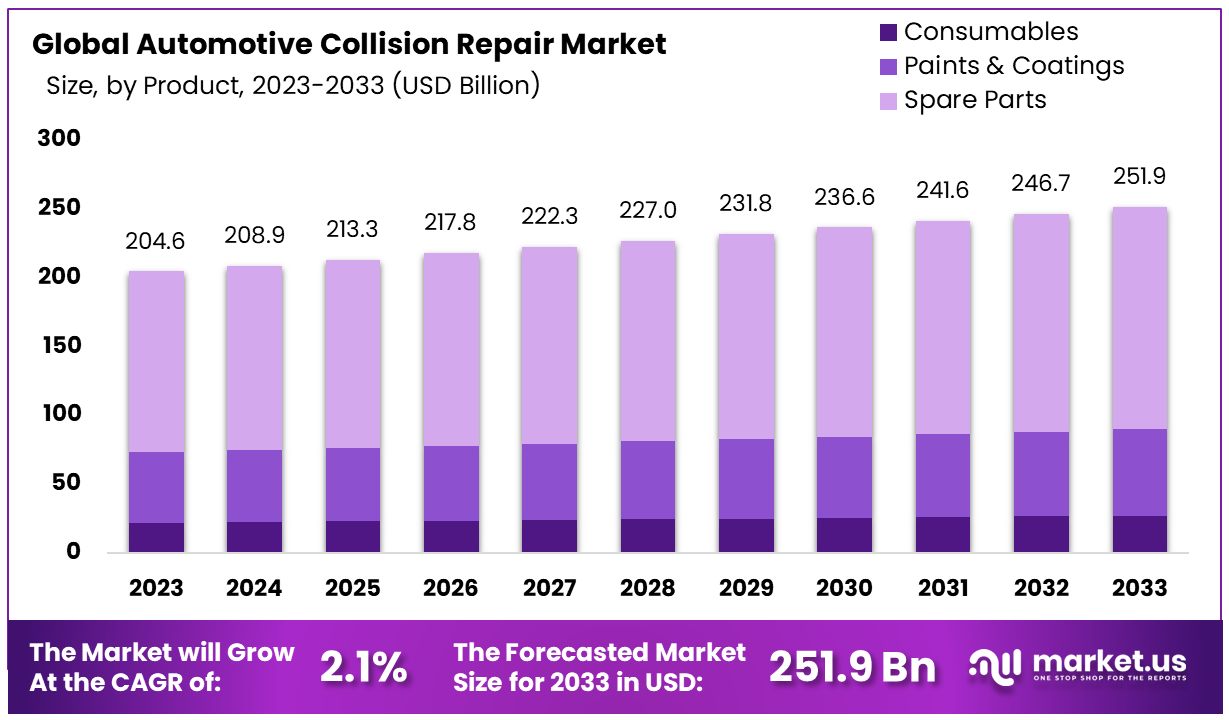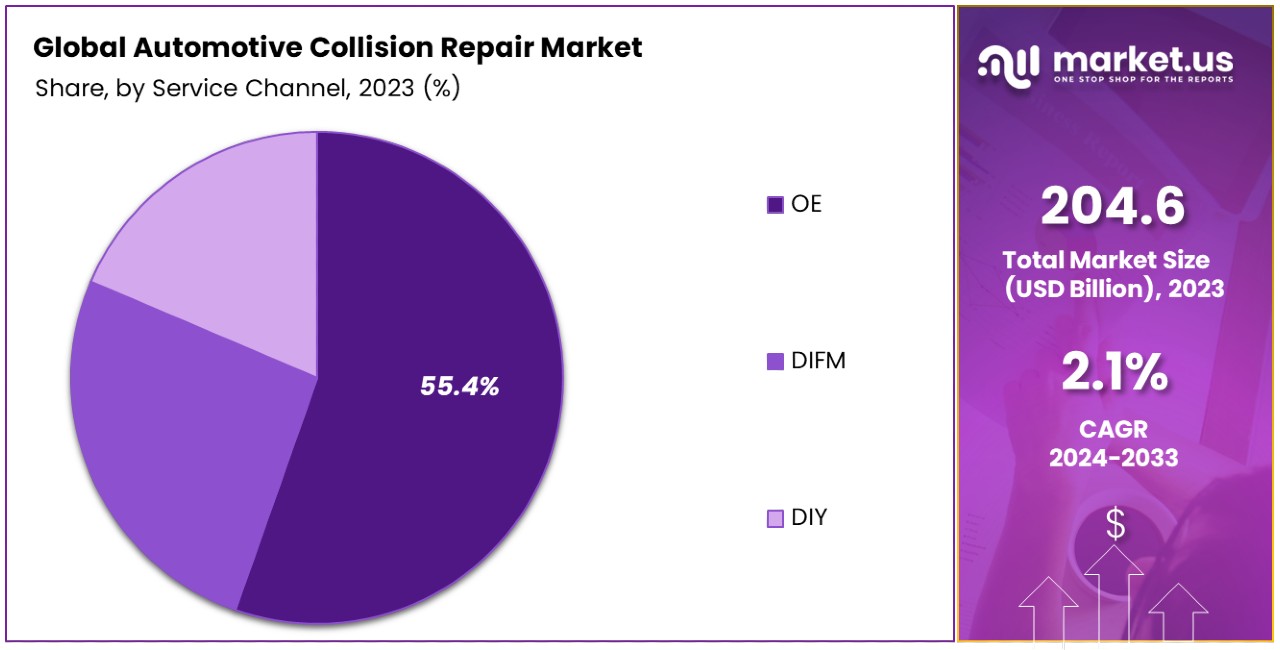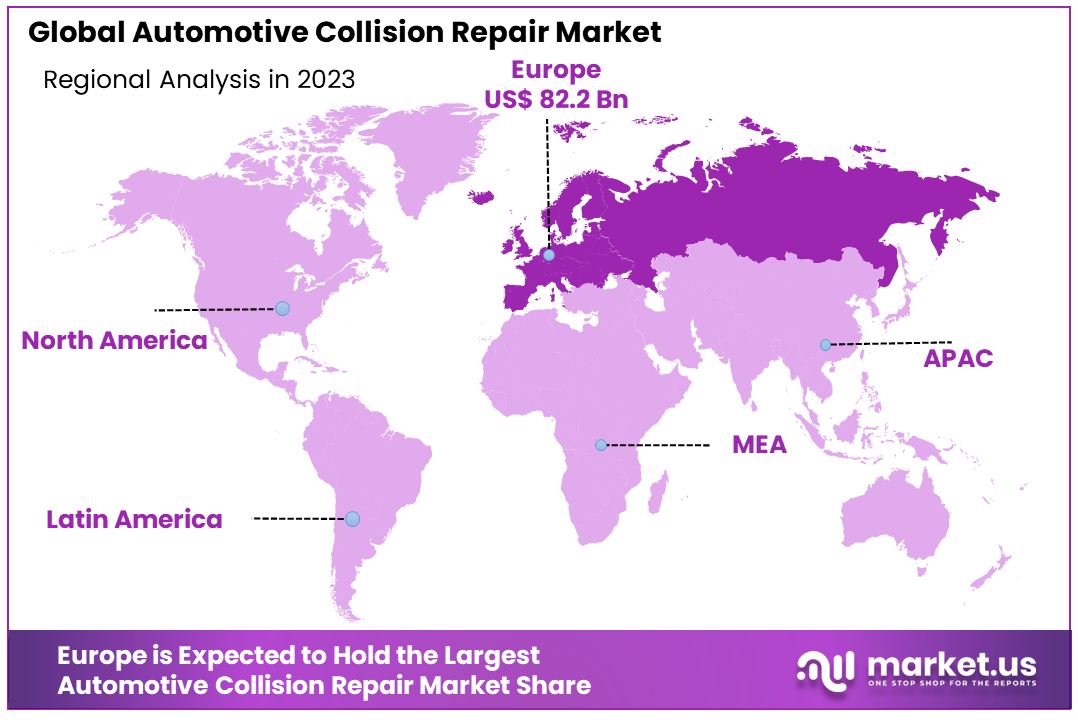Automotive Collision Repair Market Report By Product (Consumables, Paints & Coatings, Spare Parts), By Service Channel (OE, DIFM, DIY), By Vehicle Type (Heavy-duty Vehicle, Light-duty Vehicle), By Region and Companies - Industry Segment Outlook, Market Assessment, Competition Scenario, Trends and Forecast 2024-2033
- Published date: March 2024
- Report ID: 14863
- Number of Pages: 369
- Format:
- keyboard_arrow_up
Quick Navigation
Report Overview
The Global Automotive Collision Repair Market size is expected to be worth around USD 251.9 Billion by 2033, from USD 204.6 Billion in 2023, growing at a CAGR of 2.10% during the forecast period from 2024 to 2033.
The Automotive Collision Repair Market involves services and products essential for the restoration of vehicles after accidents. This market encompasses a wide range of offerings including bodywork, painting, dent removal, and replacement of parts damaged in collisions.
It caters to insurance companies, auto repair shops, and vehicle owners, ensuring vehicles are returned to their pre-accident condition. With a focus on quality, efficiency, and technological advancements, the market plays a key role in the automotive aftercare ecosystem.

The Automotive Collision Repair Market is positioned at a critical juncture, influenced by the high car ownership rates in the United States, where approximately 88% of Americans own cars. States like California, Texas, and Florida, which collectively account for 28% of all registered vehicles in the U.S., underscore the substantial potential customer base for collision repair services.
Despite the National Safety Council’s (NSC) report of a 4% decrease in motor-vehicle deaths in 2023, with 44,450 fatalities, the sheer volume of vehicles on the road indicates a steady demand for automotive collision repair services.
This market’s dynamics are shaped by factors such as technological advancements in vehicle manufacturing, the increasing complexity of repair work, and evolving insurance policies that influence repair costs and processes. The decrease in fatalities may reflect improvements in vehicle safety features and driving behaviors, yet the need for repair services remains due to non-fatal accidents and minor collisions.
Emphasizing efficient, high-quality repair services, leveraging technology for better service delivery, and aligning with insurance industry standards are key strategies. Additionally, the focus on sustainability and customer satisfaction further drives innovation in repair techniques and service offerings, ensuring the Automotive Collision Repair Market continues to thrive despite changes in vehicle technology and road safety trends.
Key Takeaways
- Market Value: The Global Automotive Collision Repair Market is projected to reach USD 251.9 Billion by 2033, experiencing growth from USD 204.6 Billion in 2023, with a CAGR of 2.10% during the forecast period from 2024 to 2033.
- Dominant Segments:
- Product Analysis: Spare Parts, leads with a significant market share of 64.3%, essential for restoring vehicles to their pre-accident condition, driven by the increasing demand for high-quality, compatible spare parts globally.
- Service Channel Analysis: Original Equipment (OE), dominates with a 55.4% market share, driven by consumer preference for OEM parts and certified repair processes, ensuring vehicle integrity and safety post-collision.
- Vehicle Type Analysis: Light-Duty Vehicles hold a significant majority with a 68.4% share, driven by their high volume globally and frequency of collisions, making them a staple in automotive collision repair.
- Regional Analysis:
- Europe: Dominates with a 40.2% market share, driven by high vehicle ownership rates and a culture of vehicle maintenance, supported by advancements in automotive technologies.
- North America: Holds approximately 25% market share, thriving on high vehicle ownership rates, comprehensive insurance coverage.
- Market Key Players: Major players include Automotive Technology Products LLC (ATP), 3M, Continental AG, Denso Corporation, Federal-Mogul LLC, Faurecia, Honeywell International Inc., Johnson Controls Inc., International Automotive Components Group.
- Analyst Viewpoint: The automotive collision repair market is witnessing steady growth driven by the increasing demand for collision repair services globally, propelled by rising vehicle ownership rates, accidents, and advancements in automotive technologies.
Driving Factors
Increasing Vehicle Ownership and Traffic Density Drives Market Growth
The automotive collision repair market is witnessing significant expansion, primarily driven by the global increase in vehicle ownership and the consequent rise in traffic density. This growth in vehicle numbers, particularly pronounced in emerging economies, directly correlates with a heightened incidence of traffic accidents and collisions.
For instance, India’s rapid escalation in vehicle ownership has notably fueled the demand for collision repair services, marking a substantial growth trajectory for the market. According to the World Bank, the global vehicle fleet is expected to double by 2040, suggesting a parallel increase in demand for collision repair services. This scenario underscores the critical relationship between vehicle proliferation and collision repair market dynamics, indicating a continuous upward trend in market demand fueled by the escalating number of vehicles on the roads.
Advancements in Vehicle Technology Propel Market Expansion
The evolution of vehicle technology, marked by advanced safety features, sophisticated electronics, and complex body designs, significantly impacts the automotive collision repair market. Modern vehicles, equipped with technologies such as advanced driver assistance systems (ADAS), require specialized repair techniques, tools, and knowledge. This technological sophistication elevates the demand for skilled professionals and certified repair facilities capable of addressing the intricate repair needs of contemporary vehicles.
For example, the integration of ADAS in vehicles necessitates precise calibration and specialized repair procedures, often beyond the scope of traditional repair shops. This shift towards more complex repair requirements has led to an increased demand for collision repair services that can adeptly handle modern technological intricacies, thereby driving market growth. As vehicles continue to evolve technologically, the collision repair market is expected to witness sustained expansion, underscored by the need for specialized repair services.
Vehicle Safety and Regulatory Compliance Fuel Market Growth
Stringent safety regulations and a strong emphasis on regulatory compliance have significantly contributed to the growth of the automotive collision repair market. Regulatory bodies and insurance companies mandate that vehicle repairs meet specific standards to ensure safety and compliance. In the United States, entities like the National Highway Traffic Safety Administration (NHTSA) alongside insurance providers, play a pivotal role in defining and enforcing standards for collision repair practices.
This regulatory landscape ensures that repairs are conducted by certified technicians using approved methods and tools, thereby upholding safety standards and compliance. Such regulations not only emphasize the importance of quality in repairs but also stimulate demand for certified collision repair services. The insistence on adherence to safety and regulatory standards propels the market forward, ensuring that the automotive collision repair industry remains aligned with evolving safety requirements and contributes positively to market growth.
Restraining Factors
Lengthy Repair Times and Vehicle Downtime Restrain Market Growth
Extended repair times and vehicle downtime significantly dampen the growth prospects of the automotive collision repair market. Delays in parts procurement, scheduling bottlenecks, and inefficiencies in repair workflows exacerbate customer dissatisfaction, as these delays disrupt daily life and routines.
Such inconveniences can deter customers from seeking repairs or encourage them to opt for quicker, albeit potentially less reliable, service providers. Efficiently managing the repair process, from streamlining workflow to ensuring timely communication with customers, can mitigate these issues. However, the prevalent challenge of lengthy repair durations remains a notable factor that limits market growth by impacting customer satisfaction and loyalty.
Quality and Consistency of Repairs Restrain Market Growth
Concerns over the quality and consistency of collision repair work, especially among independent and uncertified facilities, pose significant challenges to market expansion. Variability in repair quality, use of inferior parts, and the lack of skilled technicians contribute to customer apprehension regarding the safety and reliability of repaired vehicles.
This uncertainty can lead to a lack of consumer trust and a preference for either OEM (Original Equipment Manufacturer) services or avoidance of repairs altogether, limiting the customer base available to independent repair shops. Emphasizing the importance of certifications, rigorous quality control, and continuous training for technicians can help overcome these challenges. Nonetheless, the disparity in repair standards across the industry continues to be a key restraint on market growth, underscoring the need for uniform quality and safety benchmarks in collision repair services.
Product Analysis
In the automotive collision repair market, product segmentation reveals consumables, paints & coatings, and spare parts as pivotal categories, each contributing uniquely to the industry’s dynamics. The dominance of the spare parts segment, which currently holds a 64.3% market share, underscores its critical role in collision repair processes.
This segment’s preeminence can be attributed to the essential nature of spare parts in restoring vehicles to their pre-accident condition. As vehicles become increasingly sophisticated, the demand for high-quality, compatible spare parts escalates, further cementing this segment’s status within the market.
Spare parts encompass a broad range of components, including body panels, bumpers, door panels, and internal mechanisms, all of which are crucial for comprehensive collision repairs. The high demand for spare parts is driven by the necessity to replace damaged components to ensure that vehicles are both functional and safe to drive post-repair. This need is amplified by the global increase in vehicle ownership and the corresponding rise in accidents, which directly fuels the demand for spare parts.
The consumables segment, while not as dominant, plays an essential role in the repair process, comprising items such as adhesives, fillers, and abrasives. These materials are integral to the preparation and finishing phases of collision repair, ensuring that vehicles are not only mechanically sound but also aesthetically pleasing post-repair. The ongoing development of new materials and technologies in this segment highlights its importance in improving repair quality and efficiency.
Service Channel Analysis
The automotive collision repair market, segmented by service channel into Original Equipment (OE), Do It For Me (DIFM), and Do It Yourself (DIY), showcases the OE segment’s dominance with a 55.4% market share. This preeminence is rooted in consumers’ preference for OEM parts and certified repair processes to ensure vehicle integrity and safety post-collision. The OE segment benefits from manufacturers’ warranties and the assurance of parts’ compatibility and quality, making it a preferred choice for consumers seeking reliability and longevity in repairs.
The DIFM and DIY segments, while smaller, cater to different market needs. DIFM appeals to vehicle owners who prefer professional service but are sensitive to the costs associated with OE services, often seeking a balance between quality and price. The DIY segment, driven by hobbyists and cost-conscious consumers, thrives on the availability of aftermarket parts and the wealth of online tutorials. Despite their smaller market shares, these segments contribute to the industry’s diversity, offering options that cater to a wide range of consumer preferences and financial considerations.

Vehicle Type Analysis
In the segmentation by vehicle type, light-duty vehicles hold a significant majority with a 68.4% share, underscoring their dominance in the automotive collision repair market. This segment’s lead is attributable to the sheer volume of light-duty vehicles in operation globally, coupled with their frequency of use in daily commutes and the consequently higher likelihood of being involved in collisions. The versatility and economic value of light-duty vehicles make them a staple in both personal and commercial transportation, driving the demand for collision repair services.
Heavy-duty vehicles, although fewer in number, represent a critical segment of the market with specific repair needs due to their size and the complexity of their systems. Repairs for heavy-duty vehicles often require specialized facilities and technicians, contributing to a niche but essential market segment. The growth in commercial transportation and logistics further ensures steady demand within this segment, highlighting its importance in the broader market ecosystem.
Key Market Segments
By Product
- Consumables
- Paints & Coatings
- Spare Parts
By Service Channel
- OE
- DIFM
- DIY
By Vehicle Type
- Heavy-duty Vehicle
- Light-duty Vehicle
Growth Opportunities
Expansion of Certified Repair Networks Offers Growth Opportunity
The expansion of certified repair networks is a significant growth avenue within the Automotive Collision Repair Market. With a rising focus on vehicle safety and adherence to regulatory standards, these networks provide a platform for repair facilities to distinguish themselves. Original Equipment Manufacturers (OEMs) and insurance companies are at the forefront of this movement, establishing criteria that ensure repairs meet high-quality standards.
For instance, automotive giants like Nissan and Ford have developed certified networks that guarantee their vehicles are serviced to manufacturer specifications. This certification not only elevates the credibility of repair facilities but also broadens their appeal to consumers seeking trustworthy service providers. As these networks grow, they offer repair businesses the opportunity to capture a larger market share by aligning with consumer demand for quality and safety.
Integration of Advanced Repair Technologies Offers Growth Opportunity
Incorporating advanced repair technologies into the collision repair process unlocks significant market growth opportunities. Technologies such as 3D printing, augmented reality (AR), and artificial intelligence (AI) are revolutionizing the way repairs are conducted. For example, 3D printing allows for the rapid production of custom parts, directly impacting supply chain efficiency and cost-effectiveness.
Meanwhile, AR can guide technicians through complex repairs with visual aids and real-time data, improving accuracy and reducing repair times. AI, on the other hand, can optimize workflow management and predict maintenance issues, enhancing operational efficiency. Collision repair businesses that leverage these technologies can offer faster, more accurate, and often cost-effective services, setting themselves apart in a competitive market. The adoption of such innovations not only positions these businesses as industry leaders but also aligns with evolving consumer expectations for high-tech, efficient repair solutions.
Trending Factors
Emphasis on Sustainability and Green Practices Are Trending Factors
The automotive collision repair market is increasingly embracing sustainability and green practices, reflecting a broader industry shift towards environmental responsibility. This trend is driven by a combination of regulatory pressures, consumer preferences for eco-friendly services, and the industry’s recognition of its environmental footprint.
Repair facilities are adopting practices such as using water-based paints, which reduce volatile organic compound (VOC) emissions, implementing comprehensive waste management systems to recycle materials, and investing in energy-efficient lighting and equipment to lower energy consumption. These measures not only contribute to environmental conservation but also appeal to a growing segment of environmentally conscious consumers. As sustainability becomes a more prominent consumer value, repair shops that prioritize green practices are likely to see an uptick in customer preference, positioning themselves as leaders in a forward-thinking market.
Data Analytics and Predictive Maintenance Are Trending Factors
The integration of data analytics and predictive maintenance technologies is transforming the automotive collision repair market. This trend capitalizes on the vast amounts of data generated by modern vehicles, including sensor data and repair histories, to predict maintenance needs and prevent potential failures. By analyzing this data, repair facilities can offer targeted maintenance services that preemptively address vehicle issues, potentially reducing the likelihood of collisions and the need for more extensive repairs.
This proactive approach not only improves vehicle safety and performance but also enhances customer satisfaction by minimizing downtime and repair costs. As vehicles become increasingly connected and generate more data, the ability to effectively analyze this information and implement predictive maintenance strategies will become a competitive advantage for repair businesses. This trend towards data-driven decision-making and maintenance optimization reflects the industry’s move towards smarter, more efficient service models, highlighting the growing importance of technology and data analytics in the automotive repair sector.
Regional Analysis
Europe Dominates with 40.2% Market Share
Europe’s significant 40.2% share in the Automotive Collision Repair Market underscores its leadership in the sector. This dominance is propelled by a combination of advanced automotive technologies, stringent regulatory standards for vehicle safety and emissions, and a high density of vehicles. The region’s emphasis on sustainability and the adoption of eco-friendly practices further strengthen its market position, aligning with consumer preferences for green solutions.
Moreover, Europe’s sophisticated infrastructure for automotive repair and maintenance, coupled with the presence of major automotive manufacturers and tech companies, facilitates the integration of advanced repair technologies. These factors, combined with the region’s robust insurance sector that often mandates repairs be conducted at certified facilities, have created a fertile ground for the collision repair industry’s growth.

Market Dynamics in Different Regions
- North America: With a market share of approximately 25%, North America’s automotive collision repair market thrives on high vehicle ownership rates, a culture of vehicle maintenance, and advancements in automotive technologies. The U.S. and Canada are notable contributors to this market, driven by comprehensive insurance coverage that often includes collision repair.
- Asia Pacific: Asia Pacific is rapidly growing, holding about 20% of the market share, thanks to increasing vehicle penetration, expanding middle-class populations, and rising awareness about vehicle maintenance. Countries like China and India are pivotal, with their booming automotive sectors and growing demands for aftermarket services.
- Middle East & Africa: This region, while smaller in market share at around 8%, shows potential for growth due to increasing vehicle sales, urbanization, and an improving economic landscape, particularly in Gulf Cooperation Council (GCC) countries and South Africa.
- Latin America: Holding around 7% of the market, Latin America benefits from rising vehicle ownership and a growing emphasis on vehicle maintenance. However, economic volatility and disparities in regulatory standards across countries present challenges to uniform market growth.
Key Regions and Countries
- North America
- The US
- Canada
- Mexico
- Western Europe
- Germany
- France
- The UK
- Spain
- Italy
- Portugal
- Ireland
- Austria
- Switzerland
- Benelux
- Nordic
- Rest of Western Europe
- Eastern Europe
- Russia
- Poland
- The Czech Republic
- Greece
- Rest of Eastern Europe
- APAC
- China
- Japan
- South Korea
- India
- Australia & New Zealand
- Indonesia
- Malaysia
- Philippines
- Singapore
- Thailand
- Vietnam
- Rest of APAC
- Latin America
- Brazil
- Colombia
- Chile
- Argentina
- Costa Rica
- Rest of Latin America
- Middle East & Africa
- Algeria
- Egypt
- Israel
- Kuwait
- Nigeria
- Saudi Arabia
- South Africa
- Turkey
- United Arab Emirates
- Rest of MEA
Key Players Analysis
Within the Automotive Collision Repair Market, the listed companies collectively represent a diverse and influential group that impacts various aspects of the sector through innovation, strategic market positioning, and a broad portfolio of products and services. Companies like 3M, Continental AG, Denso Corporation, and Robert Bosch GmbH are known for their contributions to automotive safety, electronics, and advanced repair technologies. Their investments in research and development drive the integration of cutting-edge technologies into collision repair, enhancing efficiency and precision.
Firms such as Federal-Mogul LLC, Faurecia, and Honeywell International Inc. focus on parts manufacturing and supply, including advanced materials and systems that improve vehicle safety and performance. Their strategic positioning in the market supports the demand for high-quality spare parts and consumables.
Additionally, Johnson Controls Inc., International Automotive Components Group, and Magna International Inc. play crucial roles in vehicle interiors and systems, offering solutions that align with the evolving needs of the automotive repair industry, including sustainability and comfort.
Mann+Hummel Group and Martinrea International Inc., alongside Mitsuba Corporation and Takata Corporation (notwithstanding Takata’s recall issues), contribute specialized components and systems that are vital for vehicle operation and safety, underlining the importance of quality and reliability in the repair process.
Automotive Technology Products LLC (ATP) rounds out this group by offering niche products and technologies that cater to specific repair needs, emphasizing the market’s diversity.
Market Key Players
- Automotive Technology Products LLC
- 3M
- Continental AG
- Denso Corporation
- Federal-Mogul LLC
- Faurecia
- Honeywell International Inc.
- Johnson Controls Inc.
- International Automotive Components Group
- Magna International Inc.
- Martinrea International Inc.
- Mann+Hummel Group
- Mitsuba Corporation
- Takata Corporation
- Robert Bosch GmbH
Recent Developments
- On April 2024, WrenchWay, an automotive career consultancy group, launched a new tool to collect data on technician pay in the collision industry. This initiative aims to provide more accurate information than what is currently available from the U.S. Bureau of Labor Statistics (BLS).
- On March 2024, Crash Champions, a rapidly growing founder-led operator of high-quality automotive collision repair centers in the U.S., completed the acquisition of Performance Collision Centers and its nine locations spanning Virginia, South Carolina, and Georgia.
- On January 2024, CollisionRight, a leading consolidator of automotive collision repair shops in the United States, announced a majority investment from Summit Partners, a prominent growth equity investment firm.
Report Scope
Report Features Description Market Value (2023) USD 204.6 Billion Forecast Revenue (2033) USD 251.9 Billion CAGR (2024-2033) 2.10% Base Year for Estimation 2023 Historic Period 2018-2023 Forecast Period 2024-2033 Report Coverage Revenue Forecast, Market Dynamics, Competitive Landscape, Recent Developments Segments Covered By Product (Consumables, Paints & Coatings, Spare Parts), By Service Channel (OE, DIFM, DIY), By Vehicle Type (Heavy-duty Vehicle, Light-duty Vehicle) Regional Analysis North America – The US, Canada, & Mexico; Western Europe – Germany, France, The UK, Spain, Italy, Portugal, Ireland, Austria, Switzerland, Benelux, Nordic, & Rest of Western Europe; Eastern Europe – Russia, Poland, The Czech Republic, Greece, & Rest of Eastern Europe; APAC – China, Japan, South Korea, India, Australia & New Zealand, Indonesia, Malaysia, Philippines, Singapore, Thailand, Vietnam, & Rest of APAC; Latin America – Brazil, Colombia, Chile, Argentina, Costa Rica, & Rest of Latin America; Middle East & Africa – Algeria, Egypt, Israel, Kuwait, Nigeria, Saudi Arabia, South Africa, Turkey, United Arab Emirates, & Rest of MEA Competitive Landscape Automotive Technology Products LLC (ATP), 3M, Continental AG, Denso Corporation, Federal-Mogul LLC, Faurecia, Honeywell International Inc., Johnson Controls Inc., International Automotive Components Group, Magna International Inc., Martinrea International Inc., Mann+Hummel Group, Mitsuba Corporation, Takata Corporation, Robert Bosch GmbH Customization Scope Customization for segments, region/country-level will be provided. Moreover, additional customization can be done based on the requirements. Purchase Options We have three licenses to opt for: Single User License, Multi-User License (Up to 5 Users), Corporate Use License (Unlimited User and Printable PDF) Frequently Asked Questions (FAQ)
What is the projected size of the Global Automotive Collision Repair Market by 2033?The market is expected to be worth around USD 251.9 Billion by 2033. The CAGR is projected to be 2.10% during the forecast period.
Which region dominates the automotive collision repair market?Europe dominates with a 40.2% market share.
Who are some key players in the automotive collision repair market?Key players include Automotive Technology Products LLC (ATP), 3M, Continental AG, Denso Corporation, Federal-Mogul LLC, Faurecia, Honeywell International Inc., Johnson Controls Inc., International Automotive Components Group, Magna International Inc., Martinrea International Inc., Mann+Hummel Group, Mitsuba Corporation, Takata Corporation, and Robert Bosch GmbH.
 Automotive Collision Repair MarketPublished date: March 2024add_shopping_cartBuy Now get_appDownload Sample
Automotive Collision Repair MarketPublished date: March 2024add_shopping_cartBuy Now get_appDownload Sample - The 3M Company
- Automotive Technology Products LLC
- Continental AG
- Denso Corporation
- Faurecia
- Federal-Mogul LLC
- Honeywell International, Inc. Company Profile
- International Automotive Components Group
- Johnson Controls, Inc.
- Magna International Inc.
- Other Key Players
- settingsSettings
Our Clients
| Single User $4,599 $3,499 USD / per unit save 24% | Multi User $5,999 $4,299 USD / per unit save 28% | Corporate User $7,299 $4,999 USD / per unit save 32% | |
|---|---|---|---|
| e-Access | |||
| Report Library Access | |||
| Data Set (Excel) | |||
| Company Profile Library Access | |||
| Interactive Dashboard | |||
| Free Custumization | No | up to 10 hrs work | up to 30 hrs work |
| Accessibility | 1 User | 2-5 User | Unlimited |
| Analyst Support | up to 20 hrs | up to 40 hrs | up to 50 hrs |
| Benefit | Up to 20% off on next purchase | Up to 25% off on next purchase | Up to 30% off on next purchase |
| Buy Now ($ 3,499) | Buy Now ($ 4,299) | Buy Now ($ 4,999) |












